#St. Philip's Episcopal Church
Photo
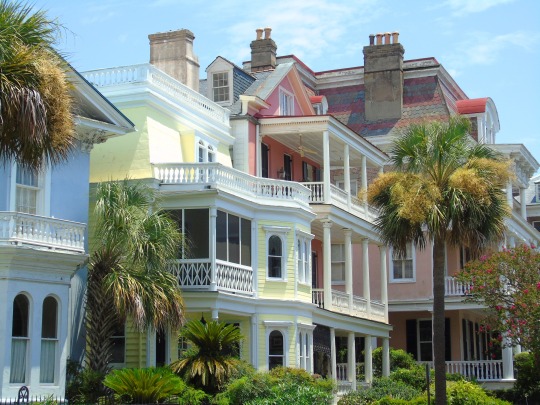
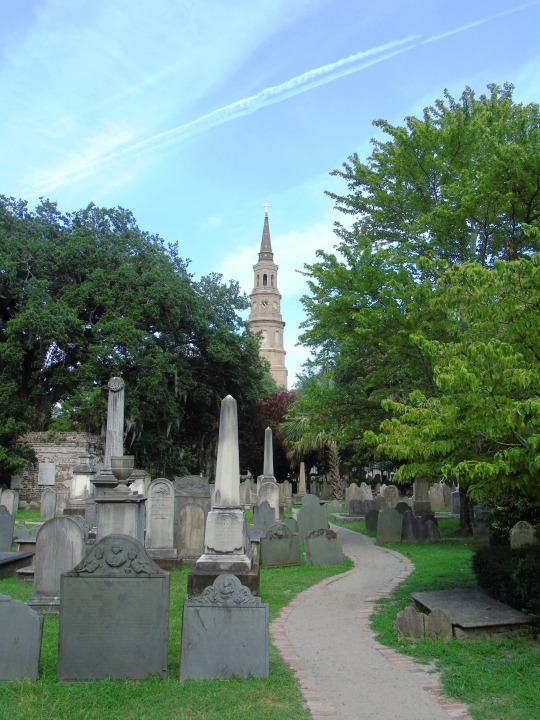


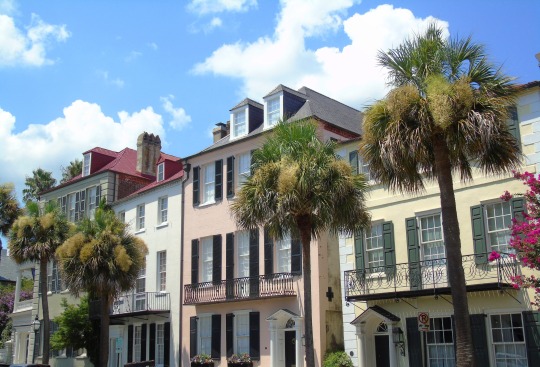
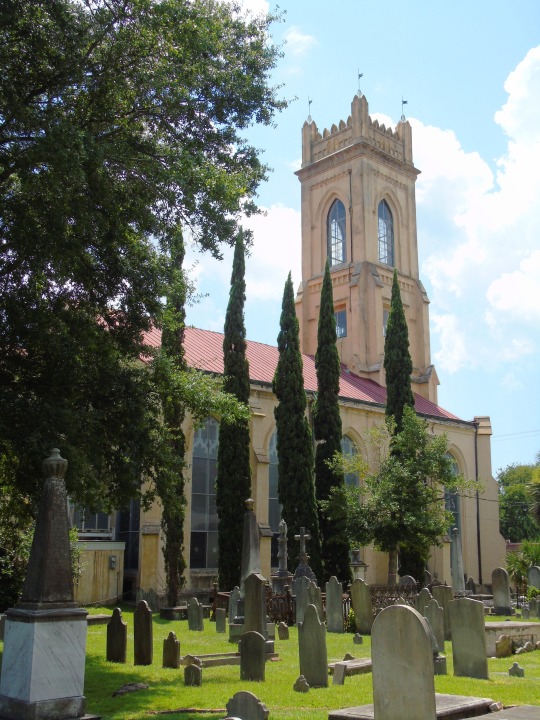

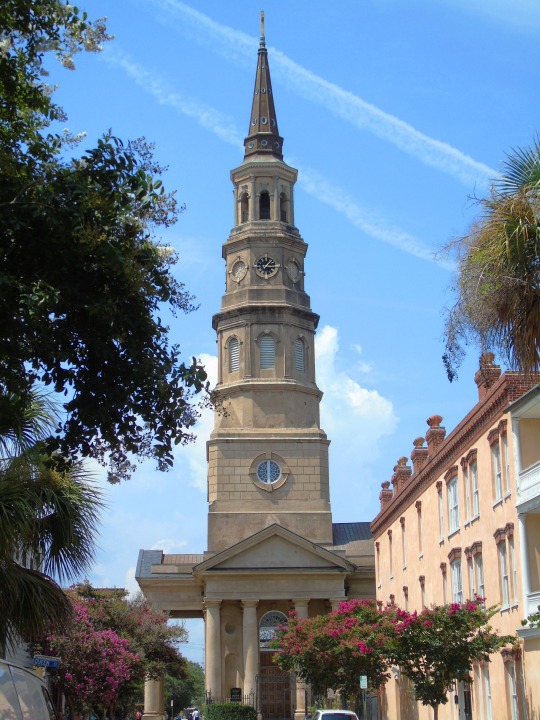
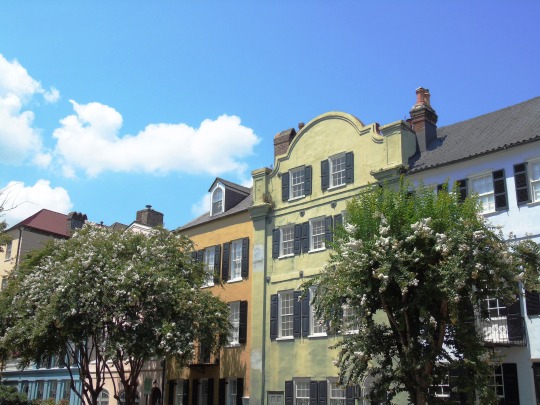

American Revolutionary War: In the largest defeat of the Continental Army, Charleston was taken by British forces on May 12, 1780.
#St. Philips Church Episcopal West Cemetery#city hall#Cathedral of St John the Baptist#Unitarian Church#Louis DeSaussure House#St. Philip's Episcopal Church#Miles Brewton House#American Revolutionary War#American War of Independence#Charleston#taken#British forces#12 May 1780#anniversary#US history#architecture#cityscape#travel#vacation#summer 2016#original photography#tourist attraction#landmark#USA#South Carolina#Southeastern Region
0 notes
Text
Rebecca Hamilton's copy of The Book of Common Prayer
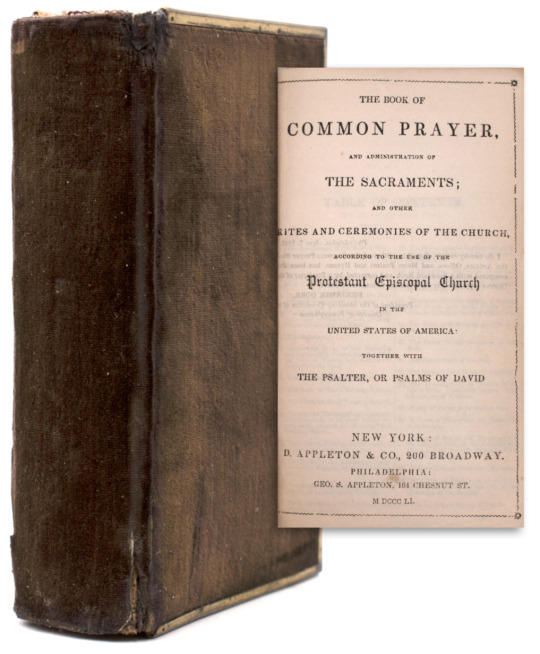
The Book of Common Prayer was initially published in 1789 and served the U.S. Episcopal Church for more than a century. It was known as The Common Pray, prior to its revision in 1892. This book is fairly similar to its predecessor, the English Book of Common Prayer from 1662, at least for the main services. This edition was published by D. Appleton in New York, 1851.
The book is presumably a ten-year anniverary present from Philip Hamilton II - the youngest son of Alexander Hamilton - to his wife, Rebecca McLane. The two were married December 29, 1842, and inside is inscribed in Phil's handwriting shows that it was gifted on December 25, 1852;
Rebecca Hamilton
From your husband
December 25, 1852

This could suggest that Rebecca had a religious character, a common tradition in the Hamilton family. Particularly Protestants from the Episcopal Church, which the book is part of.
Eliza and Hamilton were both Protestants, albeit of different denominations. Although they raised their children pretty solidly on the same virtues. After moving to New York, they both went to Trinity Church, which was an Episcopal church and some of the children were baptized there. Older brothers Philip and Alexander Hamilton Jr. were also taught by Reverend William Frazer, the rector of St. Michael's Episcopal Church. [x] Hamilton would also read the morning services of the Episcopal church to his children. [x] And Hamilton's final Holy Communion on his deathbed was given by Reverend Benjamin Moore, the second Episcopal bishop of New York. [x]
In Albany, Eliza was raised in the Dutch Reformed Church. Whereas Hamilton was raised in the Presbyterian Church, with Reverend Hugh Knox - the minister of the Presbyterian church on St. Croix - was his mentor. Later, they married at the Schuylers's home in Albany by Eliza's pastor from the Dutch Reformed Church. And Hamilton's friend, Reverend Eliphalet Nott - another Presbyterian, but a minister - delivered a well-known eulogy for Hamilton that condemned dueling. Although, Hamilton also contributed to the construction of a new Presbyterian church in Albany, and at his deathbed attended Reverend John Mason, who was a Scotch Presbyterian minister. So, he had not converted to the Dutch Reformed Church.
Source; AbeBooks
#amrev#american history#jackson era#philip hamilton ii#rebecca mclane hamilton#alexander hamilton#historical alexander hamilton#elizabeth hamilton#elizabeth schuyler#history#historical artifacts#hamilchildren#hamilton family#hamilton children#hamilkids#hamilton kids#cicero's history lessons
40 notes
·
View notes
Photo
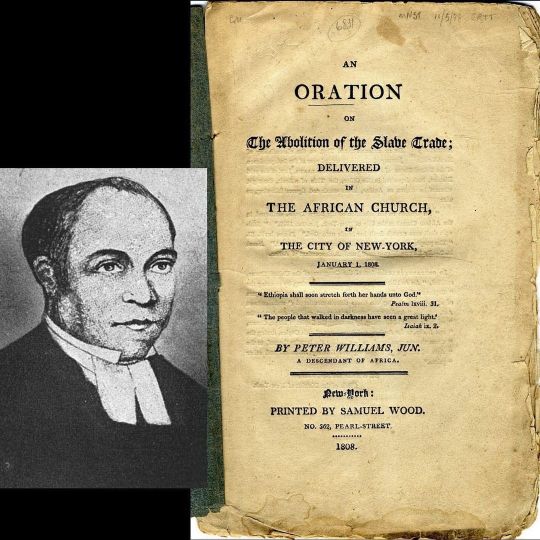
Peter Williams Jr. (1786–1840) was an African-American Episcopal priest, the second ordained in the US and the first to serve in New York City. He was an abolitionist who supported free African American emigration to Haiti, the black republic that had achieved independence in 1804 in the Caribbean. In the 1820s and 1830s, he strongly opposed the American Colonization Society's efforts to relocate free African Americans to the colony of Liberia in West Africa. In 1808 he organized St. Philip's African Church in lower Manhattan, the second African American Episcopal church in the US. In 1827 he was a co-founder of Freedom's Journal, the first African-American-owned and operated newspaper. In 1833 he founded the Phoenix Society, a mutual aid society for African Americans; that year he was elected to the executive board of the interracial American Anti-Slavery Society. He was born in New Brunswick, New Jersey, the son of Peter Williams, a Revolutionary War Veteran, and his wife, an indentured servant from St. Kitts. After his family moved to New York City, he attended the African Free School, founded by the New York Manumission Society. He was taught privately by Rev. Thomas Lyell, a prominent Episcopal priest. In 1796, his father was among the organizers of the AME Zion in New York. It developed as an independent African American denomination, the second in the US after the AME, which was founded in Philadelphia. After the American Civil War, the AME Zion Church sent missionaries to the South and planted many congregations there among freedmen. In 1808 he was chosen to give a speech on the first anniversary of the US' abolition of the international slave trade; his talk was An Oration on the Abolition of the Slave Trade; Delivered in the African Church in the City of New York, January 1, 1808. His speech was published as a pamphlet; it was one of the earliest publications by an African American about abolition. #africanhistory365 #africanexcellence https://www.instagram.com/p/CfoQbo5rDlI5VksCMU6sWQh4Io0ya7GtAZsgMI0/?igshid=NGJjMDIxMWI=
27 notes
·
View notes
Text
Today in Christian History

Today is Tuesday, May 30th, the 150th day of 2023. There are 215 days left in the year.
Today’s Highlight in History:
727: Death of Hubert, the “Apostle to the Ardennes” (a region now comprised of Northern France, Belgium, and Luxembourg).
1416: Jerome of Prague is burned for heresy by the Council of Constance. He had been a follower of reformer Jan Hus.
1525: Last preserved letter of Conrad Grebel, written from Zurich, to his brother-in-law Vadian, is a vigorous plea against attempts to suppress Anabaptists by fines, confiscation of property, imprisonment, or death.
1527: Philip of Hesse opens the University of Marburg.
1574: Death of King Charles IX of France, haunted by superstitious terrors because of the Huguenots he had ordered to be massacred in the infamous St. Bartholomew’s Day Massacre.
1639: Death of Metrophanes Kritopoulos, Orthodox patriarch of Alexandria, Egypt. His discussions with Protestants prompted him to write an exposition of Eastern Orthodox doctrine, based on the early church fathers, in an attempt to achieve Christian unity.
1792: William Carey preaches a famous sermon on Isaiah 54:2-3, before the Baptist Association meeting in Nottingham, England, at the Friar Lane Baptist Chapel, urging his listeners to "expect great things, attempt great things."
1819: At the request of his father-in-law, Anglican bishop Reginald Heber pens the words to his missionary hymn, “From Greenland’s Icy Mountains.”
1822: A slave betrays plans for a massive uprising planned by African Methodist preacher Denmark Vesey in Charleston, South Carolina. One hundred and thirty one African Americans are arrested and Vesey’s church is closed. Some of the plotters will be executed and others deported.
1858: Ordination in Maryland of Charles Grafton as a priest in the Episcopal Church. He will found the Sisters of the Holy Nativity and later, as a bishop, will stir controversy because of his fondness for ritual and vestments.
1892: Death in Lucknow, India, of Ram Chandra Bose. An ardent Christian evangelist and educator, he had written apologetics, served as a member of India’s Congress, and been a delegate to international religious conferences.
1933: Death in Boga, Congo, of African evangelist Apolo Kivebulaya.
1972: Death in prison of Watchman Nee, famed Chinese evangelist.
#Today in Christian History#May 30#ordination of Charles Grafton#death of Ram Chandra Bose#Death of Metrophanes Kritopoulos#Philip of Hesse opens the University of Marburg#Jerome of Prague is martyred
2 notes
·
View notes
Text
Extending royal authority
As Henry I sought to extend his authority over the relatively welldefined territories of England and Normandy, King Louis VI of France (1108–1137) and his son Louis VII (1137–1180) sought to improve their position relative to that of their great vassals, including Henry himself. At the beginning of his reign, as noted above, Louis VI directly controlled only a small fraction of the territory he theoretically ruled as king —the ‘royal domain’— and that area itself could be profoundly unstable. Local nobles engaged in private warfare and created a general atmosphere of fear. The contemporary writer Guibert of Nogent (c. 1060–c. 1125), wrote that a castellan named Thomas of Marle, ‘a robber of paupers and pilgrims to Jerusalem’, resisted royal authority, sought to consolidate his power, and committed countless crimes (related in stomach-churning detail) against the defenseless. It has been calculated that, in his time as a warrior, first as a prince and then as a king, Louis VI responded to some 27 documented cases of local violence or oppression. The biographer Suger insists that Louis VI could repay violence for violence. When he attacked a disruptive vassal named Ebles of Roucy, ‘the plunderers were themselves plundered and the torturers were tortured with the same or even more pain than they had used to torture others.’ Louis VI’s primary task, then, was to bring peace to the royal domain while simultaneously keeping an eye on his most dangerous vassals. Before his reign was half over, he had largely succeeded in bringing peace to the area around Paris.
He had several assets to help him consolidate his gains. First, the French crown had been safely in the hands of his Capetian dynasty since the tenth century. Most Capetians had the good fortune of long reigns, so succession disputes were rare, and at any rate Louis VI had been designated king in his father’s lifetime (possibly to guard against a rival reviving the memory of Frankish elective kingship). In addition, despite periods of relative weakness, and some rather disreputable and much-censured sexual misbehavior by his father Philip I, Louis VI’s forebears had managed to create an air of sacrality about them; they had relatively few major disputes with the Church. Because authority in France was so fragmented, the French
kings had never attained the level of control over bishops that the English and German kings had, and therefore lay investiture was a less pressing issue. Louis VI tended to negotiate with the Church regarding episcopal appointments rather than to make bold claims of theocratic kingship in order to get their way. Although France had its own version of the Investiture Controversy under Philip I, by Louis VI’s reign it had been essentially resolved, and he enjoyed mostly amicable relations with the papacy. The French kings demonstrated the sacred character of their kingship frequently and ostentatiously. The great royal abbey of St Denis, just outside Paris and rebuilt in the middle of the twelfth century, testified to royal holiness through its new Gothic elements. As early as the reign of Robert II ‘the Pious’ (996–1031), the Capetians had been thought to have the power to cure skin diseases —either scrofula or leprosy, depending on the source— as a reverberation of the healing powers of Christ. This power was also imputed to English kings, but they were apparently less successful at it.
The French kings also had more concrete, and more easily documented, means of securing their domain. Philip II had established small administrative units called Prévôtés, to allow for more orderly and manageable organization at the local level. These units were administered by royal agents, prévôts, who collected revenue, looked to royal interests, and tried to ensure some modest consistency in the meting out of justice. During the reigns of Louis VI and his son Louis VII (1137–1180), the prévôts would prove an effective means of extending royal power. But nothing was quite so effective at representing royal authority than the presence of the king himself, and French royal court was constantly traveling. Louis VI benefitted from a small core of trusted advisors, literate men with connections who helped regularize the business of government. Under mostly competent leadership, the production of written charters increased during the century: whereas an average of 5.7 royal charters per year survive from Philip I’s reign, the figure increases to 14.0 for Louis VI, and 28.1 under Philip II ‘Augustus’ (1180–1223).
Despite early difficulties with local uprisings in the royal domain, the Capetians always had their eye on the rest of France, and they intervened when they could, generally with a view to checking the power of the great princes, especially the dukes of Normandy, as Louis VI did repeatedly in the 1110s. Louis also intervened in a succession dispute in Flanders in 1126. In 1137, just before his death, he married the soon-to-be Louis VII to Duchess Eleanor of Aquitaine, which loosely joined the royal domain to much of the territory of southern France (though Eleanor’s lands were not formally integrated into those of Louis). Louis brought Eleanor with him on the Second Crusade, where she was rumored to have had dalliances with at least one other man. Partly for this reason, but also because she did not produce an heir, Louis had the marriage annulled in 1152, leading to one of the more significant instances of dynastic politics impinging on the conjoined history of France and England.
John Cotts - Europe's Long Twelth Century- Order, Anxiety and Adaptation, 1095-1229
#xii#john cotts#europe's long twelth century#louis vi#the robber barons#thomas de marle#louis vii#aliénor d'aquitaine
3 notes
·
View notes
Text
Crazy Stories From Charleston's Past in South Carolina

Charleston is a city with a rich history, and there are many interesting stories from its past. Some of these are famous tales that everyone knows about, but some are lesser-known facts that few people know about. These stories showcase what makes Charleston such an incredible place.
A pirate who terrorized Charleston’s waters is buried in the churchyard of St. Philip’s Episcopal Church.
Five miles south of Charleston, you'll find the churchyard of St. Philip's Episcopal Church. It's a peaceful place, with a wooden gazebo overlooking the harbor and mangroves growing along its edges. But there's one grave that stands out from all others: that of Captain Edward Teach (AKA "Blackbeard").
Teach terrorized Charleston in 1718 by leading two ships into their waters, capturing several merchant ships before escaping through the harbor entrance after a battle with colonial forces led by Governor Charles Eden and Colonel William Rhett Jr. To commemorate this event and honor its heroes, Charles Towne Cemetery was established in 1750 on land purchased from local planters Isaac Motte and John Wragg; it was later renamed Magnolia Cemetery when it was moved northward into town sometime after the 1820s due to expansion demands from growing population numbers throughout South Carolina during this time period."
Slave rebellion scared Charlestonians.
The most famous slave rebellion in Charleston's history is the one led by Denmark Vesey, who was a free man of color. It was planned to take place on Bastille Day, July 14, 1822. The plan involved mass murder and arson that would have destroyed much of Charleston--but luckily for us all it was foiled by the betrayal of a slave named Tom who told his owner about it!
A tidal wave rolled over Charleston in June 1886.
In June 1886, a tidal wave rolled over Charleston.
The cause was a storm that hit the coast of South Carolina on June 22 and 23, 1886. It brought with it heavy rain and winds up to 90 miles per hour--and an unusual phenomenon: the city experienced two high tides during one day.
The effect on Charleston was devastating; thousands of buildings were destroyed by flooding and many more were damaged by wind or fire after being struck by lightning bolts from the storm's fierce winds. Around 25 people lost their lives during this natural disaster as well.*
How did they discover what caused this tidal wave? A scientific team set out to investigate what happened after receiving reports from witnesses who claimed they had seen waves several feet high coming ashore at nightfall when no storms were forecasted for days ahead (so there was no way any other cause could have been responsible). They found evidence showing how large amounts of water had flowed back into Charleston Harbor due "to some obstruction which prevented its escape through its normal channels."
No one knows who paid for the construction of the Washington Monument in Marion Square.
The Washington Monument is a monument to George Washington, the first president of the United States. It's located in Marion Square, which is located in downtown Charleston.
It was built in 1856 and designed by Robert Mills. No one knows who paid for it, though some speculate that it was paid for by the people of Charleston as a thank-you to General Washington for his service during The Revolutionary War when he helped them win their freedom from England.
Mold Removal Company in Charleston, West Virginia
Mold removal services near me in Charleston, SpC Mold is one of the most toxic substances that anyone can breathe. If you have mold in your home, then you might think it’s normal to need mold removal services near me in Charleston, but mold is actually anything but natural or acceptable.
R&E Home Solutions is a trusted name in home repair services, providing a wide range of services to homeowners and contractors.
A fire that started on a small island off Charleston brought the city to a standstill for several days in the mid-1800s.

In the mid-1800s, a fire started on Sullivan's Island and spread to other islands in Charleston Harbor. The fire caused great damage to the city and was finally extinguished after several days.
The cause of this massive blaze? Lightning!
Pirates used false lights to trick ships into running aground near Sullivan’s Island.
In the 17th century, pirates used false lights to trick ships into running aground. The ships were then looted and their crew's taken, prisoner.
Sullivan's Island was one of the most popular places for this practice because it had a shallow sandbar that allowed easy access from land, but could still be hidden from view by tall trees on either side of it.
Charleston has many interesting stories from its past

The city has many interesting stories from its past. Some of them are about pirates, slave rebellions, and tidal waves. Others show how the city has changed over time. These stories are not just for tourists; they can help you understand Charleston better as well!
In 1676, pirates attacked Charles Towne (the name Charleston was given when it became a British colony). They destroyed houses and ships belonging to settlers who were trying to make their lives here in this new land called South Carolina. It wasn't until 1718 that another attack occurred--this time by Spanish soldiers from St Augustine Florida who wanted revenge against England because King George had defeated them at sea earlier that year during the War of Spanish Succession (1701-1714).
Charleston is a place with a rich history, and these stories are just a few examples of the many adventures that have taken place in this city. If you're looking for more information about these events or others from Charleston's past, be sure to check out our website!
R&E Home Solutions
778 Folly Rd d, Charleston, SC 29412
(843) 886-1658
2 notes
·
View notes
Text
Holidays 12.16
Holidays
Barbie and Barney Backlash Day
Beethoven Day
Boston Tea Party Day
Day of Reconciliation (f.k.a. Day of the Vow; South African Afrikaners)
Los Posadas begins (a.k.a. Posadas Navidenas; Mexico, Latin America)
Man Will Never Fly Memorial Society Day
National Sports Day (Thailand)
One Day At A Time Day
O Sapientia (Anglicanism)
Peter Rabbit Day
Pokemon Incident Day
Posadas Navidenas begins (Mexico)
Reconciliation Day (South Africa)
Simbang Gabi begins (Philippines)
Sophia (a.k.a. Sapinetia; Celtic Goddess of Wisdom)
Stupid Toy Day
Three-Tier System Day
Victory Day (a.k.a. Bijoy Dibosh; Bangladesh)
Victory Day (a.k.a. Vijay Diwas; India)
Wan Kila Haeng Chat (National Sports Day; Thailand)
Yuletide Lad #5 arrives (Pottasleikir or Pot-Licker; Iceland)
Food & Drink Celebrations
Eat What You Want Day
National Chocolate Covered Anything Day
St. Klippenstein's Day (Allagash) [Varies]
3rd Friday in December
National Ugly Christmas Sweater Day [3rd Friday]
Underdog Day [3rd Friday]
Independence Days
Bahrain (from UK, 1971; cerebration day only)
Kazakhstan (from USSR, 1991)
Feast Days
Ado, Archbishop of Vienne (Christian; Saint)
Adelaide of Italy (Christian; Saint)
Alice, Empress of Germany (Christian; Saint)
Beethoven Day (Pastafarian)
Crispin Glover Day (Church of the SubGenius; Saint)
Festival of Sapientia (Ancient Roman personification of wisdom & knowledge)
Festival of the Little Heat (Celebrating Bes, Ancient Egyptian Protector of the Home)
Haggai (Christian; Saint)
Martin the Turkey (Muppetism)
Newton (Positivist; Saint)
Philip K. Dick Day (Church of the SubGenius; Saint)
Ralph Adams Cram, Richard Upjohn and John La Farge (Episcopal Church USA)
Lucky & Unlucky Days
Lucky Day (Philippines) [68 of 71]
Perilous Day (13th Century England) [31 of 32]
Sakimake (先負 Japan) [Bad luck in the morning, good luck in the afternoon.]
Premieres
Avatar: The Way of Water (Film; 2022)
Battle of the Bulge (Film; 1965)
Hello, Dolly! (Film; 1969)
Hey Joe, by Jimi Hendrix (Song; 1966)
La La Land (Film; 2016)
The Magicians 9TV Series; 2015)
Mission Impossible: Ghost Protocol (Film; 2011)
The OA (TV Series; 2016)
Playtime (Jacques Tati French Film’ 1967)
The Producers (Musical Film; 2005)
Rain Man (Film; 1988)
Rogue One (Film; 2016)
Symphony No. 9 in E minor, "New World Symphony," by Antonín Dvořák (Symphony; 1893)
The Tale of Peter Rabbit (Children’s Book; 1901)
200 Motels, by Frank Zappa (Music Film; 1971)
Unplugged, by Nirvana, airs on MTV (TV Concert; 1993)
Today’s Name Days
Adelheid, Elke, Heidi (Austria)
Adela, Hagaj, Sebastijan (Croatia)
Albína (Czech Republic)
Lazarus (Denmark)
Aade, Aale, Adeele, Adelheid, Aliide, Ethel, Haide, Liide, Teele (Estonia)
Aada, Adele, Auli, Aulikki (Finland)
Alice (France)
Adelheid, Elke, Heidi (Germany)
Modestos, Theofano (Greece)
Aletta, Etelka (Hungary)
Albina (Italy)
Alvīne (Latvia)
Albina, Alina, Audronė, Vygaudas (Lithuania)
Oddbjørg, Oddbjørn (Norway)
Adelajda, Ado, Albina, Alina, Ananiasz, Bean, Zdzisława (Poland)
Agheu (Romania)
Albína (Slovakia)
Adela, Adelaida (Spain)
Assar (Sweden)
Addie, Addy, Adela, Adelaide, Adele, Adeline, Adella, Adelle, Alena, Alina, Aline, Della (USA)
Today is Also…
Day of Year: Day 350 of 2022; 15 days remaining in the year
ISO: Day 5 of week 50 of 2022
Celtic Tree Calendar: Ruis (Elder) [Day 21 of 28]
Chinese: Month 11 (Dōngyuè), Day 23 (GUI-Mao)
Chinese Year of the: Tiger (until January 22, 2023)
Hebrew: 22 Kislev 5783
Islamic: 22 Jumada I 1444
J Cal: 20 Zima; Sixday [20 of 30]
Julian: 3 December 2022
Moon: 50%: 3rd Quarter
Positivist: 14 Bichat (12th Month) [Newton]
Runic Half Month: Jara (Year) [Day 7 of 15]
Season: Autumn (Day 85 of 90)
Zodiac: Sagittarius (Day 24 of 30)
2 notes
·
View notes
Text
Tuesday, May 31, 2022
Acts 2: 1-21 (NRSV)
Read Acts 2: 1-21 on biblegateway.com
Chapter2When the day of Pentecost had come, they were all together in one place. Verse2And suddenly from heaven there came a sound like the rush of a violent wind, and it filled the entire house where they were sitting. Verse3Divided tongues, as of fire, appeared among them, and a tongue rested on each of them. Verse4All of them were filled with the Holy Spirit and began to speak in other languages, as the Spirit gave them ability.
Verse5Now there were devout Jews from every nation under heaven living in Jerusalem. Verse6And at this sound the crowd gathered and was bewildered, because each one heard them speaking in the native language of each. Verse7Amazed and astonished, they asked, "Are not all these who are speaking Galileans? Verse8And how is it that we hear, each of us, in our own native language? Verse9Parthians, Medes, Elamites, and residents of Mesopotamia, Judea and Cappadocia, Pontus and Asia, Verse10Phrygia and Pamphylia, Egypt and the parts of Libya belonging to Cyrene, and visitors from Rome, both Jews and proselytes, Verse11Cretans and Arabs-in our own languages we hear them speaking about God's deeds of power." Verse12All were amazed and perplexed, saying to one another, "What does this mean?" Verse13But others sneered and said, "They are filled with new wine."
Verse14But Peter, standing with the eleven, raised his voice and addressed them, "Men of Judea and all who live in Jerusalem, let this be known to you, and listen to what I say. Verse15Indeed, these are not drunk, as you suppose, for it is only nine o'clock in the morning. Verse16No, this is what was spoken through the prophet Joel: Verse17'In the last days it will be, God declares, that I will pour out my Spirit upon all flesh, and your sons and your daughters shall prophesy, and your young men shall see visions, and your old men shall dream dreams. Verse18Even upon my slaves, both men and women, in those days I will pour out my Spirit; and they shall prophesy. Verse19And I will show portents in the heaven above and signs on the earth below, blood, and fire, and smoky mist. Verse20The sun shall be turned to darkness and the moon to blood, before the coming of the Lord's great and glorious day. Verse21Then everyone who calls on the name of the Lord shall be saved.'
Devotion
“These are not drunk, as you suppose, for it is only nine o’clock in the morning.”
Most of us who are reading these devotions might find ourselves in worship about this time—nine o’clock in the morning. There’s a pretty good chance, however, that most of us will not be accused of being drunk at that time. But how many of us anticipate being filled with new wine? Not the wine of alcohol, but the “new wine” of God’s Spirit?
I recall reading somewhere that the Holy Spirit is called the “shy” member of the Trinity. That’s too bad, but then again, I understand. While we have significant holiday celebrations for Christmas and Easter, we hardly ever mention Pentecost. “Happy Pentecost” or “Merry Pentecost” just isn’t in our lexicon. Again, that’s too bad, but it really does need to move beyond the cultural celebrations, doesn’t it?
Perhaps we could start by pondering a question Lutherans schooled in Martin Luther’s catechism might ask: “What does this mean, this being ‘filled with new wine’?”
Prayer
God of the “new wine,” we hardly know what to pray, but are thankful that your Spirit prays for us with “sighs too deep for words” when we are at a loss for what to say. Amen.
Tom Junkert ’78 M.Div.Retired ELCA clergy, Priest in Charge, St. Philip’s Episcopal Church, Wiscasset, ME.
1 note
·
View note
Text
Holidays 12.16
Holidays
Abscondment Day (South Africa)
APS Martyrs Day (Pakistan)
Barbie and Barney Backlash Day
Battle of the Bulge Day
Beethoven Day
Boston Tea Party Day
Day of Reconciliation (f.k.a. Day of the Vow; South African Afrikaners)
Flag Day (Nepal)
Jane Austen Day
Los Posadas begins (a.k.a. Posadas Navidenas; Mexico, Latin America)
Man Will Never Fly Memorial Society Day
Mel Gibson Day (South Carolina)
National Nullification Day
National Sports Day (Thailand)
Nirbhaya Anniversary Day (India)
One Day At A Time Day
O Sapientia (Anglicanism)
Peter Rabbit Day
Pokemon Incident Day
Posadas Navidenas begins (Mexico)
Reconciliation Day (South Africa)
Simbang Gabi begins (Philippines)
Stupid Toy Day
Three-Tier System Day
Victory Day (a.k.a. Bijoy Dibosh; Bangladesh)
Victory Day (a.k.a. Vijay Diwas; India)
Wan Kila Haeng Chat (National Sports Day; Thailand)
World Digital Marketing Day
Yuletide Lad #5 arrives (Pottasleikir or Pot-Licker; Iceland)
Zionism Day
Food & Drink Celebrations
Eat What You Want Day [also 5.11]
National Chocolate Covered Anything Day
National Green Chili Day
Pinot Meunier Day
St. Klippenstein Day (Allagash) [Varies]
3rd Saturday in December
Festival of Winter Walks (UK) [3rd Saturday]
Wreaths Across America Day [3rd Saturday]
Independence Days
Bahrain (from UK, 1971; cerebration day only)
Kazakhstan (from USSR, 1991)
Secundomia (Declared; 2009) [unrecognized]
Feast Days
Ado, Archbishop of Vienne (Christian; Saint)
Adelaide of Italy (Christian; Saint)
Alice, Empress of Germany (Christian; Saint)
Beethoven Day (Pastafarian)
Carista (Day of Peace in the Family; Pagan)
Crispin Glover Day (Church of the SubGenius; Saint)
Festival of Sapientia (Ancient Roman personification of wisdom & knowledge)
Festival of the Little Heat (Celebrating Bes, Ancient Egyptian Protector of the Home)
Haggai (Christian; Saint)
Martin the Turkey (Muppetism)
Newton (Positivist; Saint)
Philip K. Dick Day (Church of the SubGenius; Saint)
Ralph Adams Cram, Richard Upjohn and John La Farge (Episcopal Church USA)
Remedios Varo (Artology)
Sophia (a.k.a. Sapinetia; Celtic Goddess of Wisdom)
Lucky & Unlucky Days
Lucky Day (Philippines) [68 of 71]
Perilous Day (13th Century England) [31 of 32]
Tomobiki (友引 Japan) [Good luck all day, except at noon.]
Premieres
Avatar: The Way of Water (Film; 2022)
Battle of the Bulge (Film; 1965)
Bottoms Up, by Brantley Gilbert (Song; 2013)
Candleshoe (Film; 1977)
Colour Blind, by Catherine Cookson (Novel; 1953)
Dirty Rotten Scoundrels (Film; 1988)
Dumb and Dumber (Film; 1994)
Elf: Buddy’s Musical Christmas (WB Animated TV Special; 2014)
The Film Fan (WB LT Cartoon; 1939)
Hello, Dolly! (Film; 1969)
Hey Joe, by Jimi Hendrix (Song; 1966)
Hoodwinked (Animated Film; 2005)
Immortal Beloved (Film; 1994)
Joyeux Noel (Film; 2005)
La La Land (Film; 2016)
Love Story (Film; 1970)
The Magicians 9TV Series; 2015)
The Merry Dwarfs (Disney Cartoon; 1929)
Mickey’s Christmas Carol (Disney Cartoon; 1983)
Mission Impossible: Ghost Protocol (Film; 2011)
The OA (TV Series; 2016)
Papillon (Film; 1973)
Playtime (Jacques Tati French Film; 1967)
The Producers (Musical Film; 2005)
Rabbit of Seville (WB LT Cartoon; 1950)
Rain Man (Film; 1988)
Rogue One: A Star Wars Story (Film; 2016)
Saturday Night Fever (Film; 1977)
Screwball Football (WB MM Cartoon; 1939)
The Seven Crystal Balls, by Hergé (Graphic Novel; 1948) [Tintin #13]
Silkwood (Film; 1983)
Sittin’ on a Backyard Fence (WB MM Cartoon; 1933)
The Small One (Disney Cartoon; 1978)
Snarf: Butterfly Follies (WB ThunderCats Cartoon; 2011)
Symphony No. 9 in E minor, "New World Symphony," by Antonín Dvořák (Symphony; 1893)
The Tale of Peter Rabbit (Children’s Book; 1901)
These Boots Are Made for Walking’, by Nancy Sinatra (Song; 1965)
To Be or Not to Be (Film; 1983)
Toy Tinkers (Disney Cartoon; 1949)
200 Motels, by Frank Zappa (Music Film; 1971)
Unplugged, by Nirvana, airs on MTV (TV Concert; 1993)
Today’s Name Days
Adelheid, Elke, Heidi (Austria)
Adela, Hagaj, Sebastijan (Croatia)
Albína (Czech Republic)
Lazarus (Denmark)
Aade, Aale, Adeele, Adelheid, Aliide, Ethel, Haide, Liide, Teele (Estonia)
Aada, Adele, Auli, Aulikki (Finland)
Alice (France)
Adelheid, Elke, Heidi (Germany)
Modestos, Theofano (Greece)
Aletta, Etelka (Hungary)
Albina (Italy)
Alvīne (Latvia)
Albina, Alina, Audronė, Vygaudas (Lithuania)
Oddbjørg, Oddbjørn (Norway)
Adelajda, Ado, Albina, Alina, Ananiasz, Bean, Zdzisława (Poland)
Agheu (Romania)
Albína (Slovakia)
Adela, Adelaida (Spain)
Assar (Sweden)
Addie, Addy, Adela, Adelaide, Adele, Adeline, Adella, Adelle, Alena, Alina, Aline, Della (USA)
Today is Also…
Day of Year: Day 350 of 2024; 15 days remaining in the year
ISO: Day 6 of week 50 of 2023
Celtic Tree Calendar: Ruis (Elder) [Day 19 of 28]
Chinese: Month 12 (Jia-Zi), Day 4 (Wu-Shen)
Chinese Year of the: Rabbit 4721 (until February 10, 2024)
Hebrew: 4 Teveth 5784
Islamic: 3 Jumada II 1445
J Cal: 20 Zima; Sixday [20 of 30]
Julian: 3 December 2023
Moon: 17%: Waxing Crescent
Positivist: 14 Bichat (13th Month) [Newton]
Runic Half Month: Jara (Year) [Day 6 of 15]
Season: Autumn (Day 84 of 89)
Zodiac: Sagittarius (Day 25 of 30)
1 note
·
View note
Text

THE DESCRIPTION OF SAINT ALPHONSUS LIGUORI
Feast Day: August 1
"A devout servant of Mary shall never perish."
The founder of the Redemptorists, formally known as the Congregation of the Most Holy Redeemer, was born Alphonsus Maria de Liguori, in Marianella, near Naples, then part of the Kingdom of Naples on September 27, 1696. He was the eldest of seven children of Giuseppe Liguori, a naval officer and Captain of the Royal Galleys, and Anna Maria Caterina Cavalieri. The family was of noble lineage, but the branch to which Liguori belonged had become somewhat impoverished.
He learned to ride and fence but was never a good shot because of poor eyesight. He was educated in the best school of the city, and took a Doctorate in Law (civil and canon law) at the age of 16.
In 1722, he lost the first case of his career at the age of 27, and fell into deep crisis. Moreover, he heard an interior voice, saying: 'Leave the world, and give yourself to me.'
Alphonsus decided to offer himself as a novice to the Oratory of St. Philip Neri in 1723, with the intention of becoming a priest. His father opposed the plan, but after two months (and with his Oratorian confessor's permission), he and his father compromised: he would study for the priesthood, but not as an Oratorian, and would live at home.
After his ordination on December 21, 1726 at age 30, Alphonsus became very popular because of his interesting and simple preaching. He said: 'I have never preached a sermon which the poorest old woman in the congregation could not understand.'
He also fought bravely against Jansenism, the heresy that supported a very strict morality. He said that the penitents should be treated as souls to be saved rather than as criminals to be punished. He is said to have never refused absolution to a penitent.
On November 9, 1732, Alphonsus founded the Congregation of the Most Holy Redeemer, with the charism of preaching popular missions in the city and the countryside. Alphonsus was well known as a moral theologian, and his masterpiece, The Moral Theology, was approved by the Pope himself.
Appointed and consecrated as the bishop of Sant' Agata de Goti by Ferdinando Maria de Rossi on June 20, 1762, he set out to reform the people and the clergy. He suspended those priests who celebrated Mass in less than 15 minutes, and sold his carriage and episcopal ring in order to give the money to the poor.
In the last years of his life, he suffered a painful sickness and a bitter persecution from his fellow priests, who had him dismissed from the congregation. He died on August 1, 1787 at the age of 90, having endured everything as trials permitted by God for his sanctification.
Canonized a saint by Pope Gregory XVI on May 26, 1839, he declared a Doctor of the Church in 1871 by Pope Pius IX. He is the patron of arthritis sufferers, lawyers, confessors, moralists and vocations.
#random stuff#catholic#catholic saints#alphonsus liguori#alphonsus maria de liguori#redemptorists#congregation of the most holy redeemer#doctor of the church
1 note
·
View note
Photo



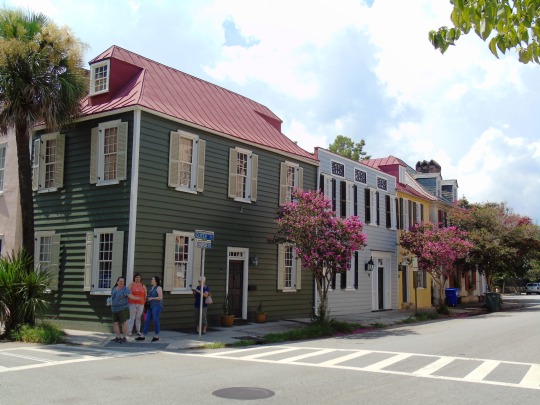

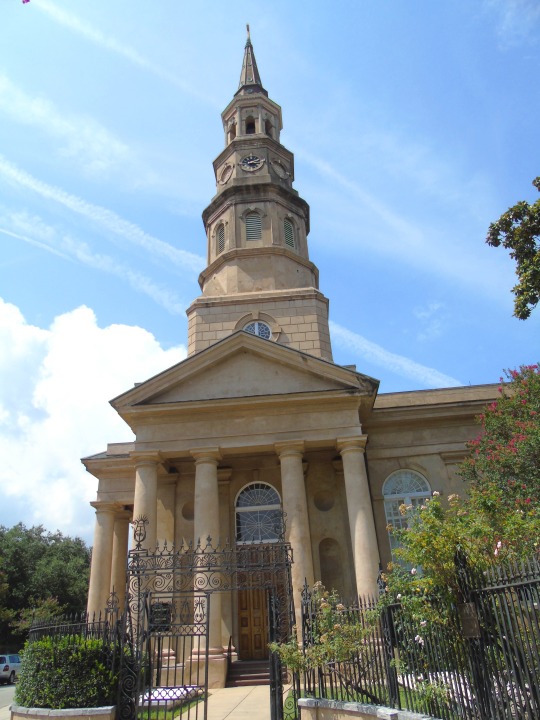




Clouds (No. 754)
Charleston, South Carolina
#Arthur Ravenel Jr. Bridge#Cooper River#Charleston#South Carolina#St. Philip's Episcopal Church#USA#street scene#summer 2016#vacation#travel#architecture#cityscape#tourist attraction#landmark#river bank#engineering#blue sky#clouds#original photography#Southern USA#flora#nature
1 note
·
View note
Text
A deeper look into Philip's plausible middle name debate
For some background to those of you who haven't seen me answer this ask yet. With some more research, I've found more considerable evidence regarding the possibility of Philip's “mysterious” middle name. I'm starting to believe it is more than likely he had the middle name, Alexander. I always wondered why Founders Archive had ever randomly given Philip an ‘A’ with his name, especially when they merely title him as just “Philip Hamilton” later. Until recently finding a piece of a facsimile of a letter from Alexander Hamilton to Philip Hamilton, when Philip is nine years old and studying under William Frazer — who was the Episcopal rector of St. Michael’s Church in Trenton;
“But determine as you like best and let me know what will be most pleasing to you. A good night to my darling son. Adieu
A Hamilton
Master Philip A Hamilton”
(source — From Alexander Hamilton to Philip Hamilton, [December 5, 1791])
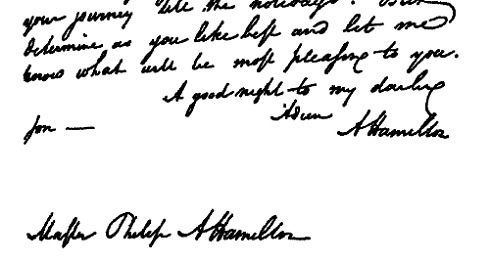
(source — via; @madamejumel)
Hamilton himself, in fact, writes Philip's name as “Master Philip A Hamilton”. There is the chance that maybe it was accidental, maybe Hamilton was so used to writing his own signature and accidentally wrote an ‘A’, as the ‘A’ noticeably does not collide with ‘Philip’ but only with his last name, much like how Hamilton's usual signature looks;

And an important note is that in Philip's only surviving letter he writes his signature as “P. Hamilton”, with no signs of a middle name. But then again, the first part of his name is shortened, so perhaps he forwent the middle name in a rush.
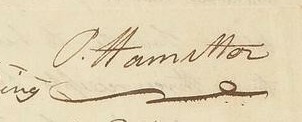
(source — WorthPoint's facsimile of a letter to Alexander Hamilton from Philip Hamilton, [21 April, 1797])
Additionally, as I mentioned in the original ask linked at the top; baptism record for the Dutch Reformed Church shows Philip Hamilton, baptized on Feb 11, 1782, with the middle name Alexander.

With all this in consideration, I'm nearly certain Philip had the middle name Alexander. With the only real considerable argument against this being that most, if not all, records of Philip after his death or just after college; always merely name him as Philip Hamilton. Even his graduation records;

(source — Catalogue of the Officers and Graduates of Columbia College (originally King's college))
Did Philip stop using his middle name after boarding school? Was it just two convenient mishaps? We will likely never know with how little material survives. But it's a interesting theory nonetheless, and very plausible Hamilton wanted a little namesake in the eldest child since he would be the prodigy and dynasty.
#amrev#american history#american revolution#alexander hamilton#historical alexander hamilton#philip hamilton#hamilton kids#hamilton family#history#hamilchildren#hamilton children#hamilkids#Cicero's history lessons#txt
46 notes
·
View notes
Photo
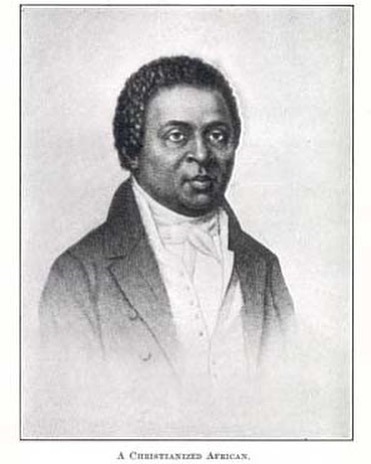
Peter Williams Jr. (1786–1840) was an African-American Episcopal priest, the second ordained in the US and the first to serve in New York City. He was an abolitionist who supported free African American emigration to Haiti, the Black republic that had achieved independence in 1804 in the Caribbean. In the 1820s and 1830s, he strongly opposed the American Colonization Society's efforts to relocate free African Americans to the colony of Liberia in West Africa. In 1808 he organized St. Philip's African Church in Manhattan, the second African American Episcopal church in the US. In 1827 he was a co-founder of Freedom's Journal, the first African-American-owned and operated newspaper. In 1833 he founded the Phoenix Society, a mutual aid society for African Americans; that year he was elected to the executive board of the interracial American Anti-Slavery Society. He was born in New Brunswick, New Jersey, the son of Peter Williams, a Revolutionary War Veteran, and his wife, an indentured servant from St. Kitts. After his family moved to New York City, he attended the African Free School. He was taught privately by Rev. Thomas Lyell, a prominent Episcopal priest. In 1796, his father was among the organizers of the AME Zion in New York. It developed as an independent African American denomination, the second in the US after the AME, which was founded in Philadelphia. After the American Civil War, the AME Zion Church sent missionaries to the South and planted many congregations there among freedmen. In 1808 he was chosen to give a speech on the first anniversary of the US abolition of the international slave trade; his talk was An Oration on the Abolition of the Slave Trade; Delivered in the African Church in the City of New York, January 1, 1808. His speech was published as a pamphlet; it was one of the earliest publications by an African American about abolition. #africanhistory365 #africanexcellence https://www.instagram.com/p/CnjjEOMLlK_/?igshid=NGJjMDIxMWI=
6 notes
·
View notes
Text
No Room at the Inn - Part 3
No Room at the Inn – Part 3
Today I share the final post of my visit to the No Room at the Inn nativity exhibit that Chris and I were able to attend a few weeks ago at St. Philip’s Episcopal Church here in Brevard, NC. It was such an amazing event and we were so happy that we were able to fit it into our schedule.
The details in this one were just amazing.
The animals in this one were just precious.
Look at those…

View On WordPress
0 notes
Text
Free Classical Concert Thursday - The Unsung Collective
Free Classical Concert Thursday – The Unsung Collective
A free concert happening this Thursday, Oct. 20 at 7:30p.m. The Unsung Collective, a community-based music ensemble of people of color devoted to celebrating stories of the Black experience, will perform classical pieces from Richter/Vivaldi and Bach at St. Philip’s Episcopal Church in Harlem. The Church is one of the oldest Black churches in NYC and was built by the first African American…

View On WordPress
0 notes
Photo

Posted @withregram • Follow @stphilipsepiscopal11228 #ThrowbackThursday In 2016 #Pridemonth took a somber turn following the tragedy at Pulse Nightclub in Miami. Our small but proud parish raised over $1200 for the survivors. St. Philip's and the Episcopal Church ⛪️ stand with our #LGBTQ+ brethren always 🌈 🙏🏼 ✝️ 👏🏼 🏳️🌈 This #Sunday our #MassontheGrass is dedicated in loving support of the community. #episcopalchurch #episcopalian #letuspray #lgbtqepiscopalians #peacebewithyou #andalsowithyou #StPhilipsEpiscopalBrooklyn #11228 #theepiscopalchurchwelcomesyou (at St. Philip's Episcopal Church) https://www.instagram.com/p/CgA37i8sSfW/?igshid=NGJjMDIxMWI=
#throwbackthursday#pridemonth#lgbtq#sunday#massonthegrass#episcopalchurch#episcopalian#letuspray#lgbtqepiscopalians#peacebewithyou#andalsowithyou#stphilipsepiscopalbrooklyn#11228#theepiscopalchurchwelcomesyou
0 notes